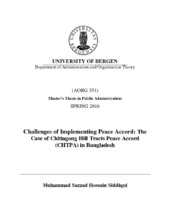| dc.description.abstract | The Chittagong Hill Tracts Peace Accord (CHTPA) was designed to maintain peace and security in the Chittagong Hill Tracts (CHT) region. The study examines the extent of policy output of the CHTPA implementation in terms of satisfaction of its targeted people with the post-Accord contexts. The study also isolates the factors that have caused variation in such satisfaction between two most similar areas in the CHT. Though the Accord has already passed nineteen years, still there is acute dearth of empirical research based on primary data in line with the perceptions and reactions of the targeted people about the CHTPA and its implementation. Considering this crucial lacuna, the study gives its focus on examining the challenges of the CHTP implementation and what factors may explain the variation in satisfaction of the beneficiaries between two most similar areas in the CHT. The study was mainly based on survey data which have also been triangulated by the Focused Group Discussions (FGDs) data. The study argued that satisfactions of the CHT people largely depends on proper management of the existing crises and also uprooting the underlying causes of future conflicts. Also better policy performance could be effective in ensuring peace and feeling of security of the targeted people in this post- Accord society. So, the study opts for such practical issues (i.e., policy output, policy performance, peace and security, etc.) relating to the CHTPA and its implementation. The crucial aspects of policy design and target groups' behaviors of Winter's integrated implementation model and the widely used concept of trust' provide the basic ideas to develop the framework for analysis of these issues. The study found that design failure of the CHTPA (i.e., poor design) and little trust of the targeted people in the implementing institutions and the successive governments are great challenges which have resulted in dissatisfactions of the majority of the respondents on policy output of the CHTPA implementation. One important reason behind the design failure was found as its too much concentration in the top-down approach of policy making that largely ignored the targeted groups' opinion, demands and aspirations. The study also found that discrimination in implementation and policy performance have caused variation in dissatisfaction between Panchhari Upazila (PU) Khagrachhari Sadar Upazila (KSU); as a result, for example, the higher tendency of occurrences of conflicts and the incidences of land alienation have been found more at PU than KSU. The study argues that proper accommodation and accumulation of the concerned actors of the CHT crisis in line with inclusive approach of designing the CHTPA could play significant roles in ensuring better policy output of the CHTPA implementation. | en_US |
